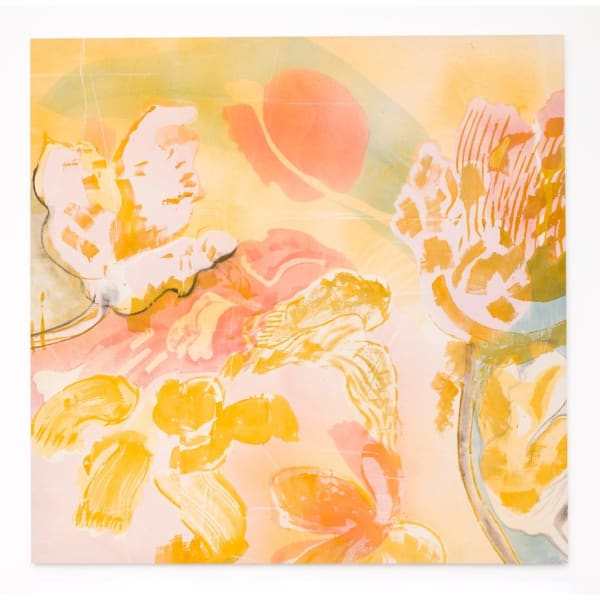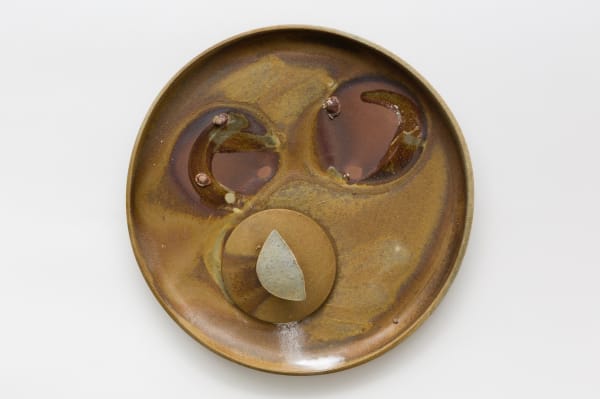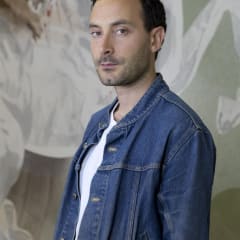Fire Sale Matthew Lutz-Kinoy
Matthew Lutz-Kinoy interviewed by Tenzing Barshee
TB: How’s the weather in São Paulo?
MLK: It was really sunny. But now it’s raining every day.
TB: This is the third time you’ve traveled to Brazil to make art. What kind of work did you make the rest time?
MLK: One day, I was working on a painting and I had the canvas out on the terrace. It didn’t take long until it was covered in black exhaust. To see this rampant pollution affected me quite a bit, and I responded by making charcoal drawings. In one of them, I merged a building with a human form—a high-heeled, skinny leggrowing out of a wavy high-rise.
TB: Didn’t you also make a drawing of a local nightclub?
MLK: There was this one club called Canthos where everyone was on GHB. Lots of plastic surgery. Many of the guys were super muscular, pumped-up gym queens who were passing out on top of one another, which triggered these thoughts on feminized bodies, curved architecture, and the merging of both. I noticed this binary gender reversal, a ip-hop of standard roles: the city is full of huge buildings that aren’t masculine and the men, I saw, were buff but vulnerable, passing out in the nightclub, topless, lying around, bending.
TB: But you didn’t approach the ideas about these bodies and buildings on a skin-oriented surface level. You considered how they come together structurally, how they’re built.
MLK: Well, I went on an LSD walk around the city with two friends, which was somehow another reversal of one’s basic social expectation. If you make yourself vulnerable, you can participate. I learned how the city is organized structurally through a series of hills and bridges. You don’t really see these layers at first, but as you walk around, you notice how high you’re standing on a hill or a bridge and how the city stretches out beneath and above you. These hills are quite gradual, they’re not extreme. All of a sudden, you’re much higher than you thought you were. It’s very effective.
TB:To what effect?
MLK: Even though São Paulo is very dense, this gives you a liberating feeling because it allows you the illusion of having a vertical access into this vast metropolis.
TB: Is it too far-fetched to make a social comparison here?
MLK: It’s a contradiction, of course. The distribution of wealth is so absurd here that most people are trapped in their social class and can only ever advance horizontally. This is one of the reasons why walking around as an outsider is quite interesting. You think that you’re moving around these different social levels in a hyper-designed urban environment, surrounded by its epic high-rises that are dispersed as a complex landscape. But unlike other cities, the high-rises aren’t a point of orientation. They’re just everywhere.You don’t necessarily see a building from many angles, as your view is mostly blocked by build- ings and other construction. They’re mostly hidden. It’s about having all these different perspectives.That feeds into all kinds of metaphors that aren’t really true to people who actually live here. Life is rough here.
TB: How did your interest in Brazilian and Japanese culture coincide?
MLK: After I left São Paulo the first time, I collaborated with Tobias Madison for a theater production based on the work of Shuji Terayama at Kunsthalle Zürich and went to Japan to do research. Right after the show in Zürich, I left for São Paulo, where I decided to make paintings titled Princess PomPom in the Villa of Falling Flowers, a character study of the protagonists of the classic piece of Japanese literature Genji Monogatari (TheTale of Genji).
TB: Can you give some background?
MLK: In São Paulo, I kept experiencing a vibrant attitude toward the body, an intense relationship to sex work for example, the ability to use pleasure as empowerment.The body becomes utilized as a space of social play and pleasure. I then participated in the gay pride parade, where you see so many people who arein the process of transition. People with small growing breasts. Three million people. It’s a whole city. I felt very emotional to see that space of potential, a different kind of narrative. It felt less masculine than similar events in the US or Europe.You have to prevent yourself from projecting too much as you fantasize about this being a political group, and you don’t understand why these people are marginalized. You want the whole parade to secede and create an alternative state lled with freaky topless glam.
TB: How did you bridge this experience to Japanese literature?
MLK: I’m generally interested in guration, which isn’t a space of metaphor but projection.That’s why it was interesting to use TheTale of Genji as a structure. Because it takes the form of a preexisting narrative that you don’t have to take responsibility for, it exists outside of you and your own forming of meaning. So you can use it as a formal structure, which allows you to work more freely. It also felt appropriate to use The Tale of Genji because of the historic relationship of Japanese immigration in Brazil, which, as a visitor, I was somehow able to relate to. I wanted to create a bridge between the corporeal frivolity I experienced, and the heavy weight of a social narrative: from this life ark, a portrait of a person, a historic, epic novel. To create a play with a type of frivolity through an accessory, something super uous and decorative. The artworks needed something frivolous beyond the picture plane, while retaining a heavy atmosphere. That’s how I came to sow the pompoms onto the paintings. I needed to push the subject.
TB: So, what works are you making now, your third time in Brazil?
MLK: I’ve been making ceramics with Silmara Watari, a Brazilian woman who studied Minguei, Chinese, and anagama pottery for thirteen years in Japan. To me, the interesting aspect of craft is the social fantasy that surrounds it. Not really how it’s made.That’s why I’m doing my ceramics here in Brazil and I’m not just nerding out on making a beautiful thing in my studio in Los Angeles.
TB: Do you treat the social narrative that surrounds ceramics as a cultural readymade?
MLK: Maybe, yes. I was already aestheticizing that in my Fire Sale dance in 2013, a performance that was one of my very rst ceramic projects. It was already objectifying social interest in craft and ceramic work. Toying with that fetish.
–
Fire Sale
It’s been awhile since Matthew Lutz-Kinoy last danced with fire. From the time when my thinking about his work began, this thought was tied to an idea of bodies, basically what makes and breaks them. In this exchange, I went as far as to objectify his artistic processes into a pinned down, marbled shelter, to think of his artist’s identity and his work as an object. Like an anatomy, multiple parts, moving, eating, talking, shifting around and on top of other structures, circling like the flight of a bird or butterfly perhaps, like winding crash barriers to our perceptiveness; this work stands as an invitation to a wide range of senses. My eyes touch on these things and some touch in return; at any rate, these wild flowers sprawl and wither away. It seems fair, to equally consider colors, shapes and the possibility of scent, growth and passing, to consider size. Today we call this process an experience. Everything is an experience and maybe it ends with that. But let’s return to the beginnings.
It’s been awhile since Matthew Lutz-Kinoy danced with fire— on May 1st, 2013 at 6:30pm, at OUTPOST Studios in Norwich, he originally presented Fire Sale, a medley of his most popular dance performances set to a live soundtrack by SOPHIE. He danced exhaustively around a flaming crate until it burned down and a series of figurative ceramic reliefs were taken from the ashes. The dance itself was as an index of previous works and, at same time, this index was objectified and transferred onto hardened objects, emancipated in its own right. Mainly at play was an interrogation of the inherently problematic idea of performance documentation, sitting somewhere between the anxiety that is the prerequisite for any document and the experience of the actual work. The artist’s preliminary interest to talk about biography, storytelling and inscribing narratives onto objects, to examine whether there’s an inherent social aspect to these privately made things— by declaring them as social because they develop a collective story around themselves—, came with the acknowledgement that developing a biography and a personality is an implied part of this process. Bodies emerged.
In November 2016, Matthew Lutz-Kinoy began working with Silmara Watari, who mastered pottery in Mashiko, Japan, producing a large set of new ceramics (around 150 pieces) in an anagama kiln somewhere in the outskirts of Campinas, Brazil. Like Matthew Lutz-Kinoy’s principal interest in the liberties of the space where performance happens and how to deal with its afterlife, these ceramic works underwent different stages of uncontrollability in a process that bounces off the aforementioned ideas. The firing itself becomes a space of the unknown, where the burning of large amounts of wood not only hardens the ceramics but produces a pile of ash, which melts with the ceramic surfaces, adding color and texture. The shape of the kiln easily reads as an anthropomorphic figure, an incalescent body of bricks cooking silently amidst a bunch of pale Brazilian greens, flushing out spiders, scorpions and big toads. The narrative of the vessel, as it is built in relation to the human body, remains to be one of the most insisting recurrences in Matthew Lutz-Kinoy’s practice. In this case, it occurs as the kiln spins out of a central force, and its ceramics get vertically pulled into being, a motion that is mimicked throughout this exhibition. In this way, the artist emphasizes the idea of a narrative, which acts as an index, testing its symbolic value. The firing lasts around five days. Once enough ash has developed and the heat plateaus around 1250° Celsius, the fire travels through the kiln-body, spraying out of the chimney, touching everything inside. The ash gets stirred by wiggling a stick or shovel, performing a type of fire dance, which creates turbulence through which the ash adheres on the glowing ceramics. The ash flakes ride the hot air like birds or a butterfly. This extends the ideas of performance, movement and indexing, beyond the placing of the clay into the kiln, in a transfer of movements of the body and the fire, even through the firing process. In the end, everything needs to cool down.
In the exhibition, the two oversized floral paintings, behave like portals, painting as space, established on large amounts of canvas, interacting with the ceramics’ humanoid forms and scroll shaped drawings. The latter act as narrative devices in lieu of language, as a schematic of the exhibition’s structure, an explanation perhaps. In general, Matthew Lutz-Kinoy exhibitions are realized as a sculptural space, which is demarcated by the different physical forms and media (ceramics, painting, drawing), emphasizing how space is expressed through figuration.
I read these different elements and their formation with a simultaneous disregard and appreciation of their utility. This comes from the double sided situation that the rooms, housing these objects, delineate as much the space of their meaning, as these objects— through their supposed or negated function—designate the identity of these rooms, labeling them vice versa. This deliberate relationship invites function where there is supposedly none, and, at the same time, fetishizes the bare idea of functionality to a point of celebrated futility.
The human body remains to be the most prominent figure, either through depiction or as a scale for dimension, these limbs carry this narrative and disperse it. This body remains a projection of a vessel, merging with inanimate objects, a dismembered and fragmented figure, scattered. This idea, a collection of ceramics as an index of human form, calls to mind an ancient tomb where the brain, lung and liver, all the different parts, are kept in separate vessels, a distributed body.
– Tenzing Barshee
-
 Matthew Lutz-Kinoy
Matthew Lutz-Kinoy -
 Matthew Lutz-Kinoy
Matthew Lutz-Kinoy -
 Matthew Lutz-Kinoy
Matthew Lutz-Kinoy -
 Matthew Lutz-Kinoy
Matthew Lutz-Kinoy -
 Matthew Lutz-Kinoy
Matthew Lutz-Kinoy -
 Matthew Lutz-Kinoy
Matthew Lutz-Kinoy -
 Matthew Lutz-Kinoy
Matthew Lutz-Kinoy -
 Matthew Lutz-Kinoy
Matthew Lutz-Kinoy -
 Matthew Lutz-Kinoy
Matthew Lutz-Kinoy -
 Matthew Lutz-Kinoy
Matthew Lutz-Kinoy -
 Matthew Lutz-Kinoy
Matthew Lutz-Kinoy -
 Matthew Lutz-Kinoy
Matthew Lutz-Kinoy -
 Matthew Lutz-Kinoy
Matthew Lutz-Kinoy -
 Matthew Lutz-Kinoy
Matthew Lutz-Kinoy -
 Matthew Lutz-Kinoy
Matthew Lutz-Kinoy -
 Matthew Lutz-Kinoy
Matthew Lutz-Kinoy -
 Matthew Lutz-Kinoy
Matthew Lutz-Kinoy -
 Matthew Lutz-Kinoy
Matthew Lutz-Kinoy




















